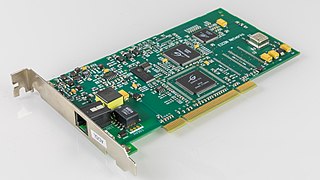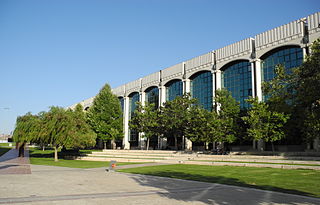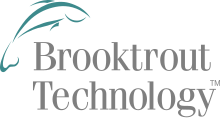
Fax, sometimes called telecopying or telefax, is the telephonic transmission of scanned printed material, normally to a telephone number connected to a printer or other output device. The original document is scanned with a fax machine, which processes the contents as a single fixed graphic image, converting it into a bitmap, and then transmitting it through the telephone system in the form of audio-frequency tones. The receiving fax machine interprets the tones and reconstructs the image, printing a paper copy. Early systems used direct conversions of image darkness to audio tone in a continuous or analog manner. Since the 1980s, most machines transmit an audio-encoded digital representation of the page, using data compression to more quickly transmit areas that are all-white or all-black.

Gateway, Inc., previously Gateway 2000, Inc., was an American computer company originally based in Iowa and South Dakota. Founded by Ted Waitt and Mike Hammond in 1985, the company developed, manufactured, supported, and marketed a wide range of personal computers, computer monitors, servers, and computer accessories. At its peak in the year 2000, the company employed nearly 25,000 worldwide. Following a seven-year-long slump, punctuated by the acquisition of rival computer manufacturer eMachines in 2004 and massive consolidation of the company's various divisions in an attempt to curb losses and regain market share, Gateway was acquired by Taiwanese hardware and electronics corporation Acer, in October 2007 for US$710 million.
GammaLink Inc. was an American computer hardware and software company founded in the 1980s in Sunnyvale, California, by Hank Magnuski and Michael Lutz. The company was the first to invent PC-to-fax communications technology, GammaFax.

Hynes Convention Center station is an underground light rail station on the Massachusetts Bay Transportation Authority (MBTA) Green Line. It is located at the intersection of Newbury Street and Massachusetts Avenue near the western end of the Back Bay neighborhood of Boston, Massachusetts. The station is named for the Hynes Convention Center, which is located about 700 feet (210 m) to the east along Boylston Street. It has two side platforms serving the two tracks of the Boylston Street subway, which are used by the Green Line B branch, C branch, and D branch. The main entrance to the station from Massachusetts Avenue leads to a fare lobby under the 360 Newbury Street building.

Delrina Corporation was a Canadian software company active from 1988 to 1995. The company was best known for WinFax, a software package which enabled computers equipped with fax modems to transmit copies of documents to standalone fax machines or other similarly equipped computers. It also sold PerForm and FormFlow, electronic form software. Delrina was acquired by the American software firm Symantec in 1995.

Zenith Data Systems Corporation (ZDS), was an American computer systems manufacturing company active from 1979 to 1996. It was originally a division of the Zenith Radio Company, after they had purchased the Heath Company and, by extension, their Heathkit line of electronic kits and kit microcomputers, from Schlumberger in October 1979. ZDS originally operated from Heath's own headquarters in St. Joseph, Michigan. By the time Zenith acquired Heathkit, their H8 kit computer already had an installed fanbase of scientific engineers and computing enthusiasts. ZDS' first offerings were merely preassembled versions of existing Heathkit computers, but within a few years, the company began selling bespoke systems, including the Z-100, which was a hybrid Z80- and 8088-based computer capable of running both CP/M and MS-DOS.
WinFax is a discontinued Microsoft Windows-based software product developed and published by Delrina designed to let computers equipped with fax-modems communicate directly to stand-alone fax machines, or other similarly equipped computers.

Eicon Networks Corporation, formerly Eicon Technology Corporation, is a privately owned designer, developer and manufacturer of communication products founded on October 12, 1984 with headquarters in Montreal, Quebec, Canada. Eicon products are sold worldwide through a large network of distributors and resellers, and supplied to OEMs.
Esker Fax from Esker is a Windows server-based fax server solution, that allows fax processing transmission and reception from both desktop clients, and host applications.

A fax modem enables a computer to transmit and receive documents as faxes on a telephone line. A fax modem is like a data modem but is designed to transmit and receive documents to and from a fax machine or another fax modem. Some, but not all, fax modems do double duty as data modems. As with other modems, fax modems can be internal or external. Internal fax modems are often called fax boards.
Fast Track Inc. was a software development company in the United States. It was founded by Robert H. Nichols in 1987 in Germantown, Maryland. The company was primarily known for its distributed network management products, primarily Exposé, which is cross-compatible with servers running VINES, NetWare, and Windows NT. It collects information from the services through the Simple Network Management Protocol (SNMP). Version 3 in 1994 introduced SuperMIB, a graphical framework for representing nodes in the network.
Dialogic Group, Inc., formerly Dialogic Corporation, was an American multinational technology company headquartered in Parsippany, New Jersey, United States. Prior to its acquisition by Enghouse Systems of Ontario in 2020, it had operations in over 25 countries. Dialogic provided a cloud-optimized communications technology for real-time communications media, applications, and infrastructure to service providers, enterprises, and developers.

Ex Libris Group is an Israeli software company that develops integrated library systems and other library software. Their headquarters is in the Malha Technology Park in southwestern Jerusalem. It has ten other offices around the world. In October 2015, Ex Libris was acquired by ProQuest which in turn was acquired by Clarivate in December 2021.

Onshape is a computer-aided design (CAD) software system, delivered over the Internet via a software as a service (SAAS) model. It makes extensive use of cloud computing, with compute-intensive processing and rendering performed on Internet-based servers, and users are able to interact with the system via a web browser or the iOS and Android apps. As a SAAS system, Onshape upgrades are released directly to the web interface, and the software does not require maintenance work from the user.
Visual Technology, Inc., was an American computer company active from 1978 to 1993 and based in Middlesex County, Massachusetts. It produced a wide variety of smart terminals compatible with a wide variety of terminal protocols—mostly those of Digital Equipment Corporation (DEC)—as well as selling terminals with their own bespoke standards. Toward the end of its existence, it focused on the production of X terminals. In 1993, Visual Technology was acquired by White Pine Software.
3R Computers, Inc., or RRR Computers, Inc., later Avatar Technologies, was an American computer company based in Westborough, Massachusetts, known for their Avatar series of dumb terminal-to-workstation devices.
Candle Corporation was an American software company active from 1976 to 2004. The company spent the first two decades developing system monitoring applications for a variety of IBM mainframes and their corresponding software, their first being OMEGAMON which saw quick widespread adoption in commercial enterprises. In the mid-1990s, the company made pivots toward non-mainframe monitoring software and middleware. IBM acquired the company for between $350 million and $600 million in 2004.
Micronics Computers, Inc. was an American computer company active from 1986 to 1998 that manufactured complete systems, motherboards, and peripherals. Based in the San Francisco Bay Area, Micronics was one of the largest domestic motherboard manufacturers in the United States in the 1990s. After acquiring Orchid Technology in 1994, the company entered the market for multimedia products, such as graphics adapters and sound cards. In 1998, Micronics was acquired by Diamond Multimedia.
Parallan Computer, Inc., was an American computer company active from 1986 to 1999 and based in Mountain View, California. The company was best known for their line of servers and collaborations with IBM for the latter's PS/2 Server range. In 1994, the company merged with Meridian Data, Inc., assuming the latter's name and marketing CD-ROM servers before moving into the network-attached storage (NAS) market with the Snap! Server. In 1999, Quantum Corporation acquired Meridian Data for $85 million.








